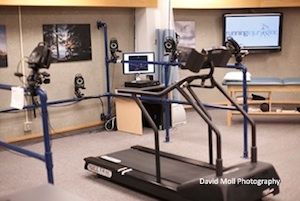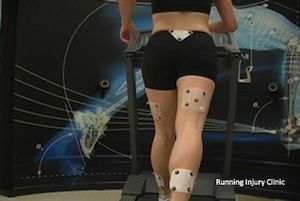3D Revolutionizes Gait Analysis
Since Aristotle’s text, “On the Gait of Animals,” human beings have been preoccupied with locomotion. While the philosopher writes of watching people’s shadows against a wall to observe gait patterns, today’s experts rely on more technical methods.
With the advent of 3D technology, gait analysis took a leap forward. What’s more, the honing of these systems over the years may have finally made them available to Joe and Jane Runner. The accuracy of the 3D systems are supported by both scientific and anecdotal evidence, making them perhaps the next big thing when it comes to treating and preventing running injuries.
3D Technology for the Masses
The use of 3D technology for gait analysis dates back to 1990. At the University of Calgary, Assistant Professor Dr. Reed Ferber, also the founder of the Running Injury Clinic in Calgary, uses a 3D system with eight cameras to gather data and images while research participants run on the treadmill. “I’ll tell you the exact degree your foot is overpronating. We can see if your lower leg is rotating appropriately with your foot and how much torsional force is being created at your knee,” explains Ferber.
Dr. Irene Davis, professor of physical therapy at the University of Delaware, utilizes a similar six-camera system in her Motion Analysis Laboratory. “In the lab, we measure mechanics in 3D and provide the runner with real time feedback on those mechanics,” says Dr. Davis. She argues, however, that offering this technology in the clinical setting may not be realistic. “At the end of the day, clinics aren’t going to have the manpower or financial resources for these expensive systems,” she says.
Dr. Ferber contends that the cost of such equipment has dropped dramatically over the past few years and that his system is real-world ready. “With respect to training, our software is turn-key in its use. We’re trying to make it relatively easy for the clinician to use this sophisticated technology to understand the root cause of an injury,” he explains.
He began putting the system to the test this April at a clinic in downtown Calgary, offering it to the general public for the first time. With the use of the 3D gait analysis system, he can observe runners’ overall biomechanics and gather data on the their flexibility, strength and alignment. With those four points of reference, he runs the numbers against two-and-a-half years worth of biomechanical profiles in his lab’s database and prints off a report to show patients the potential root cause of their injuries and what they might do to remedy them.
Dr. Ferber also offers healthy patients information on how to prevent injuries. “Based on those four pieces of the puzzle, we can say: You have a 63 percent chance of getting injured.” Dr. Ferber’s job is to help the runner understand how to lower their injury risk score. “We want to change the way runners think about their bodies and how they can reduce their risk,” he says. “We are making scientific decisions about what a runner needs to work on; we’re not taking a shot in the dark, we’re not guessing.”
Both Dr. Davis and Dr. Ferber agree that for a highly trained biomechanist, 2D high-speed cameras can also be accurate. “There’s nothing that takes the place of experience,” says Dr. Davis. “As you see more patients, you gradually develop your evaluation skills. With time, you begin to see specific mechanics associated with particular injuries.” While Dr. Ferber concurs, he believes that many of the people doing gait analyses simply don’t have the knowledge to be able to be able to provide precise feedback. He says that the 3D gait analysis system can offer this regardless of the operator’s background.
Plan of Action
While the cutting-edge gait analysis system will be of interest to techies, runners simply want to know what they can do to get healthy and resume running. Upon completing a gait analysis, Dr. Ferber and Dr. Davis offer differing methods of rehabilitation and injury prevention. While Dr. Ferber tends to use strength and flexibility prescriptions for his patients, Dr. Davis is partial to gait retrainment.

Burning at each end of the candle, both have found success in their approaches. “I’m going to change a runner’s mechanics by getting them stronger and more flexible. Within six weeks, 90 percent of my runners are injury free,” says Dr. Ferber (results will be published soon in the Journal of Athletic Training).
Dr. Davis explains her research: “Our data suggests that you can alter the gaits of runners who are at risk for injury.” To do this she uses a treadmill and a mirror, giving the runner visual feedback on form and cadence.
Regardless of the rehabilitation protocol, gait analysis is becoming an increasingly important part of preventing and treating running injuries. Having seen success in his Calgary Clinic, Dr. Ferber already has plans to bring 3D gait analysis to Alberta, British Columbia and beyond. There is much anticipation for how this technology will affect the way we diagnose and treat running injuries. Aristotle would surely have been impressed.

